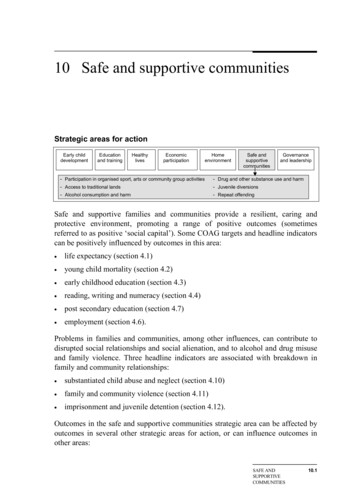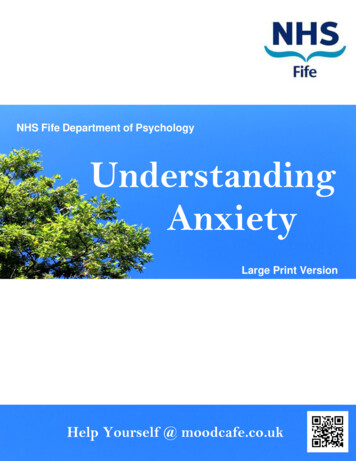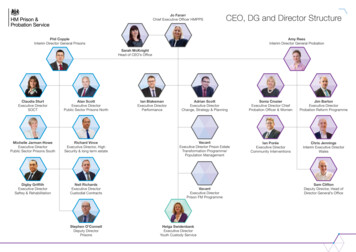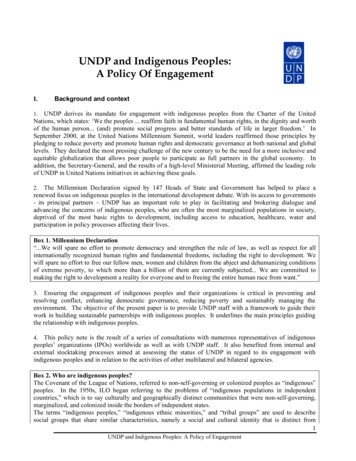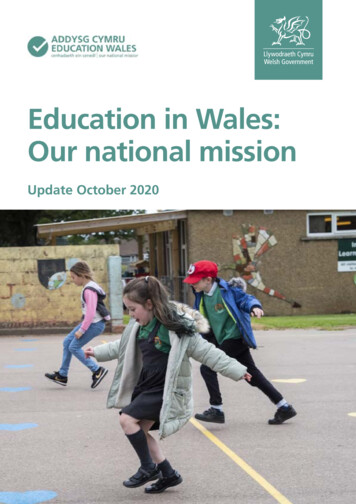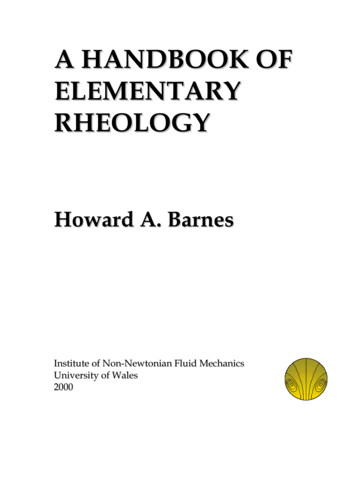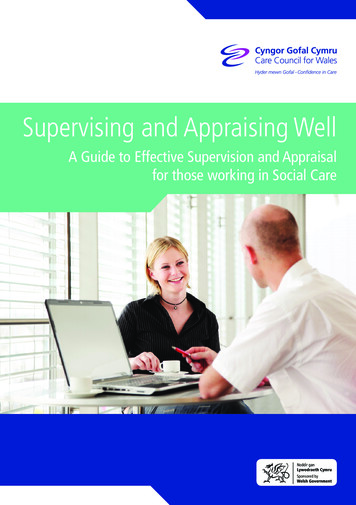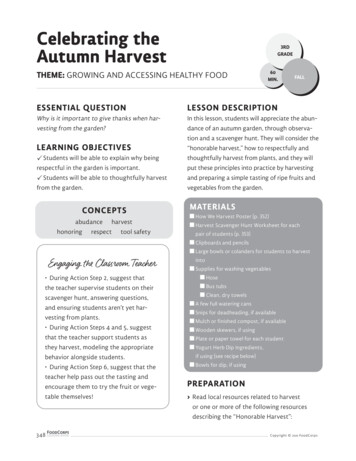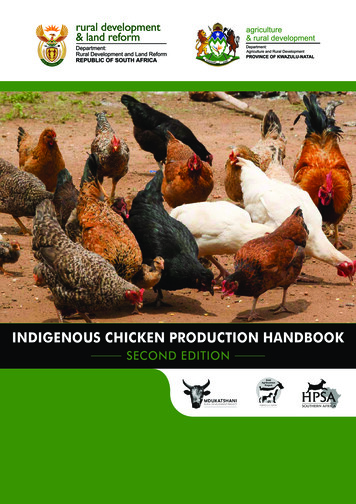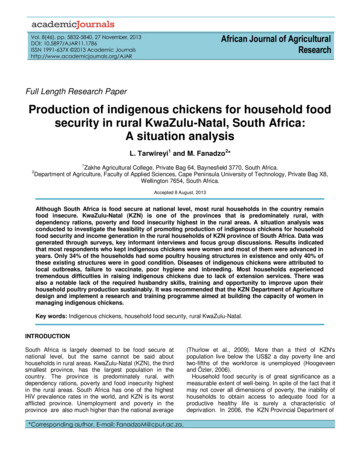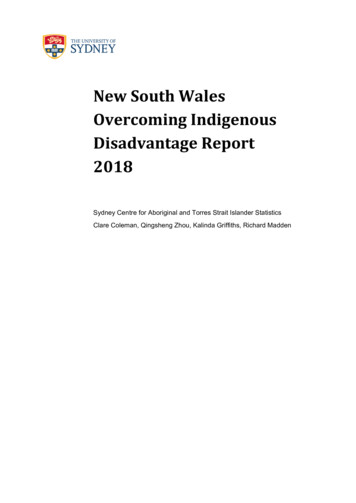
Transcription
New South WalesOvercoming IndigenousDisadvantage Report2018Sydney Centre for Aboriginal and Torres Strait Islander StatisticsClare Coleman, Qingsheng Zhou, Kalinda Griffiths, Richard Madden
Published by:University of Sydney, NSWISBN: 978-0-6481939-4-4Copyright August 2018Suggested citation: Coleman, C., Zhou, Q., Griffiths, K., and Madden, R. (2018). New SouthWales Overcoming Indigenous Disadvantage Report 2018, University of SydneyAcknowledgments:The analysis presented in this paper was funded by Aboriginal Affairs, NSW Department ofEducation. The views expressed in this paper are those of the authors and may not reflect thoseof Aboriginal Affairs or the New South Wales Government.The format for this report was designed to correspond to the Overcoming IndigenousDisadvantage 2106 (OID) and acknowledges the copyright of that report. We acknowledge theCouncil of Australian Government’s (COAG) work on the OID report.Layout and publishing assistance: Rodney BernardNSW Overcoming Indigenous Disadvantage Report 2018
ContentsList of Figures . iiiAcronyms and Abbreviations . vGlossary . viIntroduction. 1COAG Targets . 54.1Life Expectancy. 5Life Expectancy. 5Mortality Rates . 64.2Young child mortality . 8Infant mortality rates . 8Young child mortality. 94.3Early childhood education . 11Early childhood preschool enrolment . 11Early childhood preschool attendance . 124.4Reading, writing and numeracy . 13Proportion of students at or above the NMS for NAPLAN reading, writing and numeracy . 13Participation in NAPLAN testing. 144.5Years 1 to 10 School Attendance . 17School attendance . 17Number and proportion of schools achieving 90 per cent or greater average schoolattendance . 184.6Year 12 attainment . 19The proportion of the 20 24 year old population who have attained at least a Year 12 orequivalent qualification. 19Students who have attained an Australian Tertiary Admission Rank (ATAR) of 50.0 orabove . 204.7Employment . 22Employment to population ratio. 22Labour force participation . 23Unemployment rate. 24NSW Overcoming Indigenous Disadvantage Report 2018i
Headline Indicators . 254.8Post-secondary education . 25People with or working towards a post-secondary qualification . 254.9Disability and chronic disease. 27Disability prevalence . 27Participation in society by people with a disability . 28Carers of people with disability . 284.10 Household and individual income . 29Median equivalised gross weekly household income. 294.11 Substantiated child abuse and neglect . 30Substantiation of child protection notifications . 30Children on care and protection orders . 32Out-of-home care placement . 344.12 Family and community violence . 36Incidence and prevalence of violence . 36Victimisation rates . 37Hospitalisation Rates . 39Homicide rates . 39People who seek services due to family violence homelessness . 404.13 Imprisonment and juvenile detention . 41Adult imprisonment . 41Juvenile detention . 42Community-based youth justice supervision . 43iiNSW Overcoming Indigenous Disadvantage Report 2018
List of FiguresFigure 1: NSW Population pyramid by age, sex and Aboriginality 2016 Census . 4Figure 2: NSW change in life expectancy for Aboriginal people by gender,from 2005–2007 to 2010–2012 . 5Figure 3: NSW age-standardised three year rolling average mortality rates by Aboriginality,2007–2014 . 6Figure 4: NSW infant mortality rates using a rolling 3 year average by Aboriginality, 2007–2015 . 8Figure 5: NSW child (1 – 4 years) mortality rates using a rolling 3 year average by Aboriginality,2007–2015 . 10Figure 6: Percentage of children enrolled in preschool programs in NSW and Australia byAboriginality, 2014–2016 . 11Figure 7: NSW students (percentage) at or above the NMS in reading in Years 3, 5, 7 and 9 byAboriginality, 2008–2017 . 13Figure 8: NSW students (percentage) at or above the NMS in writing in Years 3, 5, 7 and 9 byAboriginality, 2011–2017 . 14Figure 9: NSW students (percentage) at or above the NMS in numeracy in Years 3, 5, 7 and 9 byAboriginality, 2008–2017 . 14Figure 10: NSW students (percentage) participating in NAPLAN reading test by Aboriginality, 2008–2017 . 15Figure 11: NSW students (percentage) participating in NAPLAN writing test by Aboriginality, 2008–2017 . 15Figure 12: NSW students (percentage) participating in NAPLAN numeracy test by Aboriginality,2008–2017 . 15Figure 13: NSW school attendance by Aboriginality, 2014–2017 . 17Figure 14: Proportion of 20-24 year olds who have attained at least Year 12 in NSW and Australiaby Aboriginality, 2006–2016 . 19Figure 15: ATAR rates (50.0 or above) in NSW and Australia by Aboriginality, 2007–2015 . 20Figure 16: Proportion of NSW working age population employed by Aboriginality, 2004–2015. 22Figure 17: NSW Labour force participation rate by Aboriginality, 2004–2015 . 23Figure 18: NSW unemployment rate by Aboriginality, 2004–2015 . 24Figure 19: Proportion of people with a Certificate III qualification or above or working towards onein NSW and Australia by Aboriginality, 2001–2016 . 25Figure 20: Age-standardised proportion of with profound or severe core-activity limitation in NSWand Australia by Aboriginality, 2002–2015 . 27Figure 21: Median equivalised gross weekly household income (2014–15 dollars) in NSW andAustralia by Aboriginality, 2002 to 2014–15 . 29Figure 22: Children aged 0–17 years who were subject of a substantiated child protection report inNSW and Australia by Aboriginality, 2009-10 to 2016-17. 30Figure 23: Rate of children aged 0–17 years on care and protection orders in NSW by Aboriginality,2005-2017 . 32Figure 24: Placement of Aboriginal children in out-of-home care in NSW, at 30 June 2005-17 . 34NSW Overcoming Indigenous Disadvantage Report 2018iii
Figure 25: Proportion of adults’ self-reported experiencing physical or threatened violence in NSWand Australia by Aboriginality, 2002, 2008 and 2014-15 . 36Figure 26: NSW rate of sexual assaults by Aboriginality 2010-2017 . 37Figure 27: NSW rate of assaults by Aboriginality 2010-2017 . 38Figure 28: NSW rate of robberies by Aboriginality 2010-2017 . 38Figure 29: NSW age-standardised imprisonment rate per 100 000 by Aboriginality, 2000–2017 . 41Figure 30: NSW Daily average rate of detention of young people aged 10–17 years by Aboriginality,2007-08 to 2016-17 . 43Figure 31: NSW Daily average rate of community supervision of young people aged 10–17 years byAboriginality, 2007-08 to 2016-17 . 44ivNSW Overcoming Indigenous Disadvantage Report 2018
Acronyms and AbbreviationsABSAustralian Bureau of StatisticsACARAAustralian Curriculum, Assessment and Reporting AuthorityAHSAustralian Health SurveyAIHWAustralian Institute of Health and WelfareAQFAustralian Qualifications FrameworkATARAustralian Tertiary Admission RankCDEPCommunity Development Employment ProjectsCOAGCouncil of Australian GovernmentsEGWHEquivalised gross weekly householdGSSGeneral Social SurveyHPFHealth Performance FrameworkNAPLANNational Assessment Program – Literacy and NumeracyNATSIHSNational Aboriginal and Torres Strait Islander Health SurveyNATSISSNational Aboriginal and Torres Strait Islander Social SurveyNEHSNational Eye Health SurveyNIRANational Indigenous Reform AgreementNMSNational Minimum StandardNSWNew South WalesOIDOvercoming Indigenous DisadvantageSDACSurvey of Disability Aging and CarersSHSSpecialist Homelessness ServicesNSW Overcoming Indigenous Disadvantage Report 2018v
GlossaryGlossaryAboriginalA person who identifies as being of Aboriginal origin. May also includepeople who identify as being of both Aboriginal and Torres StraitIslander origin.Age standardisedratesAge standardised rates enable comparisons to be made betweenpopulations that have different age structures. Age standardisation isoften used when comparing the Aboriginal and Torres Strait Islanderand non-Indigenous populations because the Aboriginal and TorresStrait Islander population is younger than the non-Indigenouspopulation. Outcomes for some indicators are influenced by age,therefore, it is appropriate to age standardise the data when comparingthe results. When comparisons are not being made between the twopopulations, the data are not age standardised.Care and protectionordersIf an investigation results in a substantiation, intervention by childprotection services might be needed to protect the child. Thisintervention can take a number of forms, including one or more of:referral to other services; supervision and support; an application tocourt; and a placement in out-of-home care. The types of care andprotection orders available vary across jurisdictions and may includeinterim and temporary orders, finalised supervisory orders, andfinalised guardianship or custody orders (see substantiation).CDEPCommunity Development Employment Projects (CDEP) was anAustralian Government funded program that provided activities forunemployed Aboriginal and Torres Strait Islander Australians todevelop work skills and move into employment (see section 4.7).Child mortalityChild mortality is typically defined as the number of deaths of childrenunder five years of age in a given year.Core activitylimitation (ABSSDAC definition)Four levels of core activity limitation are determined based on whethera person needs help, has difficulty, or uses aids or equipment with anyof the core activities (mobility, self-care and communication). Aperson's overall level of core activity limitation is determined by theirhighest level of limitation in these activities.The four levels of limitation are:profound — the person is unable to do, or always needs help with, acore activity task.severe — the person:– sometimes needs help with a core activity task, and/or– has difficulty understanding or being understood by family or friends,or– can communicate more easily using sign language or other nonspoken forms of communication.moderate — the person needs no help, but has difficulty with a coreactivity taskviNSW Overcoming Indigenous Disadvantage Report 2018
Glossarymild — the person needs no help and has no difficulty with any of thecore activity tasks, but:– uses aids or equipment, or has one or more of the followinglimitations– cannot easily walk 200 metres– cannot walk up and down stairs without a handrail– cannot easily bend to pick up an object from the floor– cannot use public transport– can use public transport, but needs help or supervision– needs no help or supervision, but has difficulty using public transport.Confidence intervalsSurvey data, for example data from the Australian Aboriginal andTorres Strait Islander Health Survey, are subject to sampling errorbecause they are based on samples of the total population. Wheresurvey data are shown in charts in this report, error bars are included,showing 95 per cent confidence intervals. There is a 95 per centchance that the true value of the data item lies within the intervalshown by the error bars. See ‘statistical significance’.See also ‘Error bars’.Disability (ABSSDAC definition)A person has a disability if he or she has a limitation, restriction orimpairment, which has lasted, or is likely to last, for at least six monthsand restricts everyday activities. These activities include: loss of sight(not corrected by glasses or contact lenses); loss of hearing wherecommunication is restricted, or an aid to assist with, or substitute for,hearing is used; speech difficulties; shortness of breath or breathingdifficulties causing restriction; chronic or recurrent pain or discomfortcausing restriction; blackouts, seizures, or fits, or loss ofconsciousness; difficulty learning or understanding; incomplete use ofarms or fingers; difficulty gripping or holding things; incomplete use offeet or legs; nervous or emotional condition causing restriction;restriction in physical activities or in doing physical work; disfigurementor deformity; mental illness or condition requiring help or supervision;long-term effects of head injury, stroke or other brain damage causingrestriction; receiving treatment or medication for any other long-termconditions or ailments and still restricted; or any other long-termconditions resulting in a restriction.ICDICD is the International Statistical Classification of Diseases andRelated Health Problems, endorsed by the World Health Organization(WHO). It is primarily designed for the classification of diseases andinjuries with a formal diagnosis. ICD-10-AM is the Australianmodification of the tenth revision and was adopted for Australian usefrom 1 January 1999 (superseding ICD-9).NSW Overcoming Indigenous Disadvantage Report 2018vii
GlossaryEquivalisedhousehold incomeEquivalised household income adjusts the actual incomes ofhouseholds to make households of different sizes and compositionscomparable. It results in a measure of the economic resourcesavailable to members of a standardised household (see section 4.10).Error barsSurvey data, for example data from the Australian Aboriginal andTorres Strait Islander Social Survey, are subject to sampling errorbecause they are based on samples of the total population. Wheresurvey data are shown in charts in this report, error bars are included,showing 95 per cent confidence intervals. There is a 95 per centchance that the true value of the data item lies within the intervalshown by the error bars. See ‘statistical significance’.See also ‘Confidence intervals’.Income rangesSee ‘quintiles’.IndigenousA person of Aboriginal and/or Torres Strait Islander origin whoidentifies as an Aboriginal and/or Torres Strait Islander Australian.Indigenous statusnot stated/Indigenous statusunknownWhere a person’s Indigenous status has either not been asked or notrecordedInfant mortalityDeaths of children between birth and exactly one year of age.Inner regionalSee ‘remoteness areas’.JurisdictionThe Australian Government or a State or Territory Government andareas that it has legal authority over.Labour forceThe labour force is the most widely used measure of the economicallyactive population or the formal supply of labour. It is a measure of thenumber of people contributing to, or willing to contribute to, the supplyof labour and, as defined by the ABS, comprises two mutuallyexclusive categories of population: the employed (people who haveworked for at least one hour in the reference week), and theunemployed (people who are without work, but had actively looked forwork in the four weeks up to the end of the reference week and wereavailable to start work in the reference week).Major citiesSee ‘remoteness areas’.viiiNSW Overcoming Indigenous Disadvantage Report 2018
GlossaryMean and medianincome measuresMean income value is the average value of a set of income data. It iscalculated by adding up all the values in the set of data and dividingthat sum by the number of values in the dataset.Median value is the middle point of a set of income data. Lining up thevalues in a set of income data from largest to smallest, the one in thecentre is the median income value (if the centre point lies between twonumbers, the median value is the average value of the two numbers).Mean income values are influenced by extreme income values(including the lowest and highest incomes). Therefore, median incomevalue is a more informative measure of income for an averagehousehold or individual income earner. .Non-AboriginalA person who does not identify as Aboriginal and/or Torres StraitIslander.Non-IndigenousA person who does not identify as Aboriginal and/or Torres StraitIslander.Non-schoolqualificationNon-school qualifications include vocational or higher educationqualifications.Non-remoteSee ‘remoteness areas’.Out of home careplacementChildren are placed in out-of-home care as a last resort when it is notin their best interests to remain with their family. Placement of anAboriginal child in out-of-home care is prioritised in the following way: with Aboriginal relatives or extended family members, or otherrelatives or extended familywith Aboriginal members of the child’s communitywith other Aboriginal and Torres Strait Islander Australians.Outer regionalSee ‘remoteness areas’.Perinatal mortalityFetuses delivered with a gestational age of 20 weeks or more, orweighing at least 400 grams, and all neonatal deaths –deaths within 28days of birth.Post-schoolqualificationPost-school qualifications include vocational or higher educationqualifications.QuintilesIncome quintiles are groups that result from ranking all people in thepopulation in ascending order (from the lowest to the highest)according to their (as an example) incomes and then dividing thepopulation into five equal groups, each comprising 20 per cent of thepopulation.NSW Overcoming Indigenous Disadvantage Report 2018ix
GlossaryRate ratioThe rate ratio is the rate for the Aboriginal and Torres Strait Islanderpopulation divided by the rate for the non-Indigenous (or other)population.RegionalSee ‘remoteness areas’.Relative standard/error (RSE)The relative standard error is the standard deviation of the sampledivided by the mean of the sample. See also ‘statistical significance’.RemoteSee ‘remoteness areas’.RemotenessSee ‘remoteness areas’.Remoteness areasRemoteness areas are defined in the Australian StatisticalGeographical Standard (ASGS) developed by the ABS.1The ASGSremoteness classification identifies a place in Australia as having aparticular degree of remoteness. The remoteness of each place isdetermined using the Accessibility/Remoteness Index of Australia(ARIA). The ABS generates an average ARIA score for each locationbased on its distance from population centres of various sizes.Locations are then added together to form the remoteness areas ineach State and Territory. Remoteness areas comprise the following sixcategories: major cities of Australiainner regional Australiaouter regional Australiaremote Australiavery remote Australiamigratory regions (comprising off-shore, shipping and migratoryplaces).The aim of the ASGS remoteness structure is not to provide a measureof the remoteness of a particular location but to divide Australia intofive broad categories (excluding migratory regions) of remoteness forcomparative statistical purposes.Statisticalsignificance1xStatistical significance is a measure of the degree of differencebetween survey data estimates. The potential for sampling error — thatis, the error that occurs by chance because the data are obtained fromonly a sample and not the entire population — means that reportedresponses may not indicate the true responses.The ASGS replaced the Australian Standard Geographical Classification (ASGC) from 1 July 2013.NSW Overcoming Indigenous Disadvantage Report 2018
GlossaryUsing the relative standard errors (RSE) of survey data estimates, it ispossible to use a formula to test whether the difference is statisticallysignificant. If there is an overlap between confidence intervals fordifferent data items, it cannot be stated for certain that there is astatistically significant difference between the results. See ‘confidenceintervals’ and ‘relative standard error’.SubstantiationSubstantiations is defined as the rate of Aboriginal and Torres StraitIslander children who were the subject of substantiated child protectionnotifications.Torres Strait IslanderpeoplePeople who identify as being of Torres Strait Islander origin. May alsoinclude people who identify as being of both Torres Strait Islander andAboriginal origin.Unemployment rateThe unemployment rate is defined as the proportion of people in thelabour force who: had actively looked for full-time or part-time work at any time inthe four weeks up to the end of the reference week, or were waiting to start a new job within four weeks from the endof the reference week and could have started in the referenceweek if the job had been available then.Very remoteSee ‘remoteness areas’.NSW Overcoming Indigenous Disadvantage Report 2018xi
IntroductionIntroductionIn this report we respectfully refer to the Aboriginal and Torres Strait Islander people of NewSouth Wales (NSW) as Aboriginal people, in recognition that Aboriginal people are the originalinhabitants of NSW.2 When referring to all of Australia we will respectfully refer to Aboriginal andTorres Strait Islander people as Indigenous people or Aboriginal and Torres Strait Islanderpeople.This report updates the NSW Overcoming Indigenous Disadvantage 2017 report for the sectionswhere new data is available. This report provides data for NSW corresponding to the ProductivityCommissions’ Overcoming Indigenous Disadvantage Report (2016) for the Commonwealth. Thereport covers only the Council of Australian Governments (COAG) targets and the HeadlineIndicators, corresponding to Sections 4.1–4.13 of the Productivity Commission’s report. Weprovide NSW specific information on the seven COAG targets, main measures andsupplementary items where applicable and where this information is available for NSW. We alsoreport on the main measures of five headline indicators and supplementary items whereapplicable and where this information is available for NSW. Each section discusses the datalimitations and the sources of the data. This report uses the corresponding topic headings fromChapter 4 of the OID Report, ‘COAG targets and headline indicators’. The updated sections areSections 4.2-4.6, 4.8 and 4.11-4.13.Where information has been sourced from census data, such as the Australian Bureau ofStatistics (ABS) Census of Population and Housing, ABS Prisoners of Australia or from AustralianCurriculum, Assessment and Reporting Authority (ACARA) education data there are no error barsin the figures, as the summary data are considered to be exact. Where data has been sourcedfrom surveys, the summary data are estimates and therefore 95 per cent confidence intervals aredisplayed on the figures.Data limitationsWith preliminary estimates of the NSW Aboriginal population from the 2016 census of 265 600people, when looking at subgroups of the population, the counts of relatively rare events can bequite small and therefore subject to large fluctuations. For example, between 2006 and 2015 theannual number of deaths of children between the ages of 1 and 4 years ranged from three toeight. This year to year variability makes it difficult to identify if any trends are present. Some ofthe data used in the OID report is based on unpublished analysis by the ABS and the AustralianInstitute of Health and Welfare (AIHW). These data have not been updated. Data quality isaffected by the propensity to identify as Aboriginal. Further information about data limitations isincluded in each section of the report.Data sourcesThis report is based on publicly available data from AB
NSW Overcoming Indigenous Disadvantage Report 2018 v Acronyms and Abbreviations ABS Australian Bureau of Statistics ACARA Australian Curriculum, Assessment and Reporting Authority
